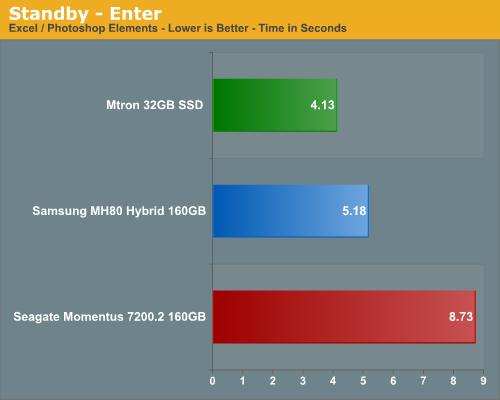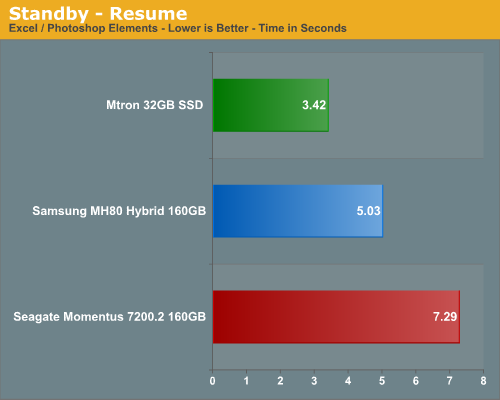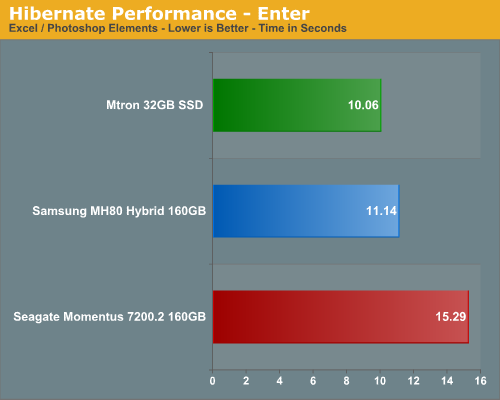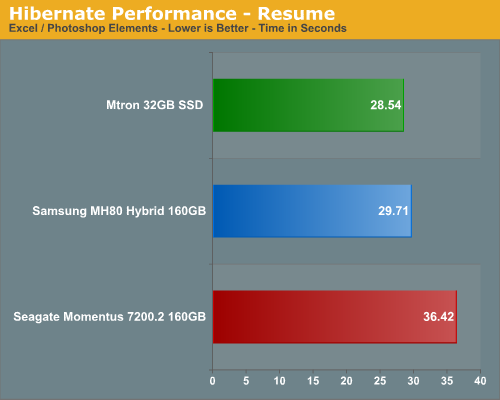Operating System Performance
The following tests are designed to indicate the drives ability to load and shutdown Windows Vista Home Premium along with entering and resuming from hibernation.
Windows Vista Standby and Resume
These tests are fairly straight forward with our application timer measuring the time it takes for Windows Vista to enter standby with Excel and Photoshop Elements active with a large spreadsheet and several test images open. The Resume test measures the time it takes for the system to return to the desktop once the resume process is initiated.


This test is dependent on write speeds for the standby section and read speeds for the resume operation. Windows Vista has been highly touted for its ability to use internal flash memory to write and store data for immediate retrieval via ReadyDrive so we should see some benefits with the Samsung drive.
In our standby tests, the Samsung Hybrid drive is only a second slower than the MTRON unit. Our MTRON drive is over 4 seconds faster than the Seagate drive at entering standby which is 111% faster (it sounds very impressive using that measurement technique). Our resume tests follow the same pattern with the MTRON unit being almost 4 seconds faster than the Seagate drive and about a second and a half faster than the Samsung drive. Our initial test results show promise for the hybrid drive design and Windows Vista.
Windows Vista Hibernate and Resume
Our Hibernate test measures the time it takes for Windows Vista to enter hibernation with Excel and Photoshop Elements active with a large spreadsheet and several test images open. The Resume test measures the time it takes for the system to resume to the desktop and includes the POST time of our notebook unit.


Our MTRON SSD unit is able to enter hibernation 15% faster than the Samsung and 52% quicker than the Seagate unit. Actual hibernate times of the MTRON unit are just over 1 and 5 seconds quicker than the Samsung and Seagate drives respectively. The MTRON SSD resumes 4% faster than the Samsung and 28% faster than the Seagate drive. Based upon the advantages of low latencies and always on capability we expected these results with the SSD based drive but were pleasantly surprised by the performance of the Samsung Hybrid drive.
The resume results indicate the advantages of the SSD design in not having a mechanical spin-up and seek process along with increased access times in locating files. The Hybrid design compensates for the most part compensates by mitigating the slower mechanical operation with the large 256MB NAND flash buffer and Vista's ReadyDrive capability.
The following tests are designed to indicate the drives ability to load and shutdown Windows Vista Home Premium along with entering and resuming from hibernation.
Windows Vista Standby and Resume
These tests are fairly straight forward with our application timer measuring the time it takes for Windows Vista to enter standby with Excel and Photoshop Elements active with a large spreadsheet and several test images open. The Resume test measures the time it takes for the system to return to the desktop once the resume process is initiated.


This test is dependent on write speeds for the standby section and read speeds for the resume operation. Windows Vista has been highly touted for its ability to use internal flash memory to write and store data for immediate retrieval via ReadyDrive so we should see some benefits with the Samsung drive.
In our standby tests, the Samsung Hybrid drive is only a second slower than the MTRON unit. Our MTRON drive is over 4 seconds faster than the Seagate drive at entering standby which is 111% faster (it sounds very impressive using that measurement technique). Our resume tests follow the same pattern with the MTRON unit being almost 4 seconds faster than the Seagate drive and about a second and a half faster than the Samsung drive. Our initial test results show promise for the hybrid drive design and Windows Vista.
Windows Vista Hibernate and Resume
Our Hibernate test measures the time it takes for Windows Vista to enter hibernation with Excel and Photoshop Elements active with a large spreadsheet and several test images open. The Resume test measures the time it takes for the system to resume to the desktop and includes the POST time of our notebook unit.


Our MTRON SSD unit is able to enter hibernation 15% faster than the Samsung and 52% quicker than the Seagate unit. Actual hibernate times of the MTRON unit are just over 1 and 5 seconds quicker than the Samsung and Seagate drives respectively. The MTRON SSD resumes 4% faster than the Samsung and 28% faster than the Seagate drive. Based upon the advantages of low latencies and always on capability we expected these results with the SSD based drive but were pleasantly surprised by the performance of the Samsung Hybrid drive.
The resume results indicate the advantages of the SSD design in not having a mechanical spin-up and seek process along with increased access times in locating files. The Hybrid design compensates for the most part compensates by mitigating the slower mechanical operation with the large 256MB NAND flash buffer and Vista's ReadyDrive capability.










25 Comments
View All Comments
fc1204 - Monday, August 20, 2007 - link
well, the mtron uses a fpga as it's controller. they do what companies like adtron and stec (formerly simpletech) do to market ssd to clients- price is the concern after reliability and performance are satisfied.in the next year or two, you will start seeing asic controller-based ssd's. these will be more like the sandisk prices as opposed to the mtron prices.
on a side note, for those asking raid 0 ssd's, i need to comment that it will be harder to implement this in a viable consumer application because the price is just a bit more than the benefits- power-consumption and mobile-ruggedness (people have 600+watt psu's and cases that don't bounce while in operation) and laptops are replacing desktops in homes.
pqi has a ssd that is using raiding 2 cf controllers. we can always hope that anand gets more ssd's and crack them open.
DeepThought86 - Friday, August 17, 2007 - link
C'mon, we're all waiting for the RAID 0 results with these things!Spoelie - Sunday, August 19, 2007 - link
Actually a valid point, I'm wondering about possible problems in SSDs. Without the moving parts, reliability in RAID0 might make it more viable for desktop use.Are most of the defects predictable (i.e. this cell has been written to 1000 times and shouldn't be used anymore) and partly fixable (like having a table which designates broken cells, over time the capacity would go down then but no data lost, till it is replaced)?
Xenoterranos - Friday, August 17, 2007 - link
The HDD Tach chart for the SSD made me lol. Just seeing a flat line on a HDD performance chart makes me feel all warm and fuzzy inside.Spoelie - Sunday, August 19, 2007 - link
I thought someone died :(The other lines look more heatbeaty :D
Slaimus - Friday, August 17, 2007 - link
Who are they targetting with this insane price?brundlefly - Sunday, August 19, 2007 - link
MTRON isnt even marketing this to consumers - its a product generally sold for military and industrial use where shock and heat tolerances are high.However, I ordered it for a database drive, and it is actually one of the cheapest and simplest ways to improve the performance of disk i/o bound large tables.
Spoelie - Sunday, August 19, 2007 - link
If you read the previous article, you'd know, it's not meant for desktop use due to it's extremely rugged design;"The drive is marketed into the commercial, server, and industrial sectors with an emphasis placed on performance storage needs with a high degree of tolerance to environmental conditions."
i.e. specialized systems in low volume markets, not commoditized desktop systems.
Also, the other SSD's may be cheaper, but as also mentioned in the other article;
"These specifications far exceed those of the latest SanDisk and Samsung consumer SSD products that are approaching 67MB/sec read speeds and 45MB/sec write speeds"
You always pay a price for performance.
In conclusion, these articles are more of a future outlook on storage technology, not really about something regular joe will buy in a mom 'n pop store.
AnnihilatorX - Saturday, August 18, 2007 - link
I agree. SanDisk's 32GB is just $500Axbattler - Friday, August 17, 2007 - link
What is the cost of the Seagate and Samsung? It doesn't look like the inclusion of a relatively large Flash buffer is able to fully compensate for the slower rotational speed at all time. But it does edge the Seagate in a few instance leading me to think that if the cost premium is not too high, it is not unthinkable for traditional HD to 'evolve' into hybrids in next couple of years. A hybrid version of a Raptor should be quite interesting.SSD is looking very good here, but even with significant price decrease each year, I do not see those become 'mainstream' for quite some time. Increasingly affordable for the enthusiasts (desktop), and flagship/customised high end laptop sure. But we are not going to see those in every HP/Dell desktop (or even laptop) for quite some time IMO. Then again, have other HD manufacturers (WD, Hitachi, Seagate) announced their own plans for hybrids?